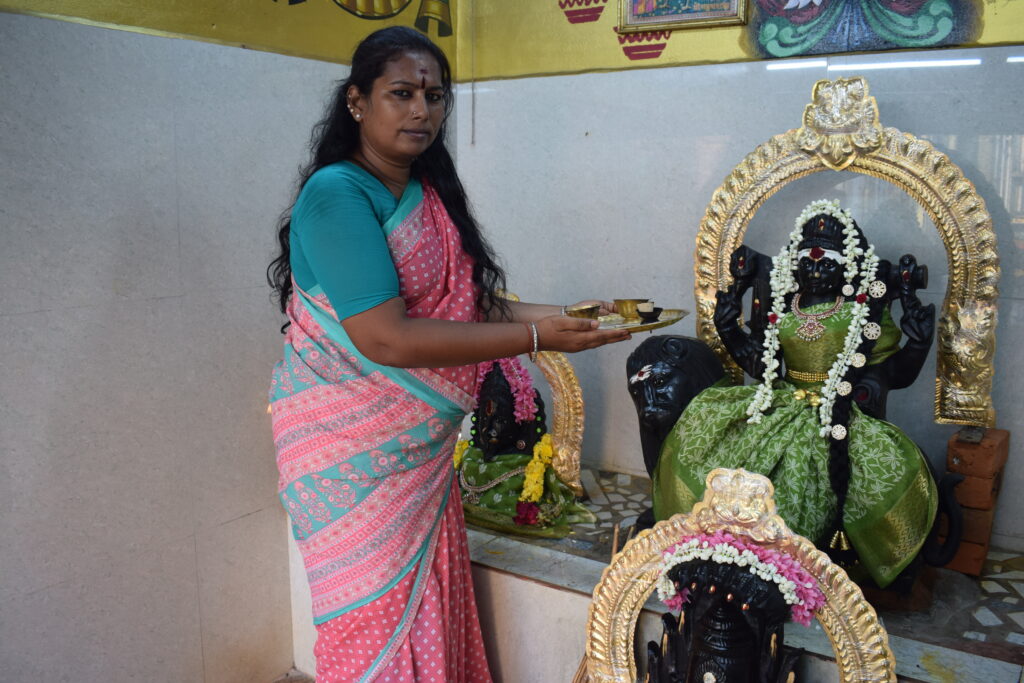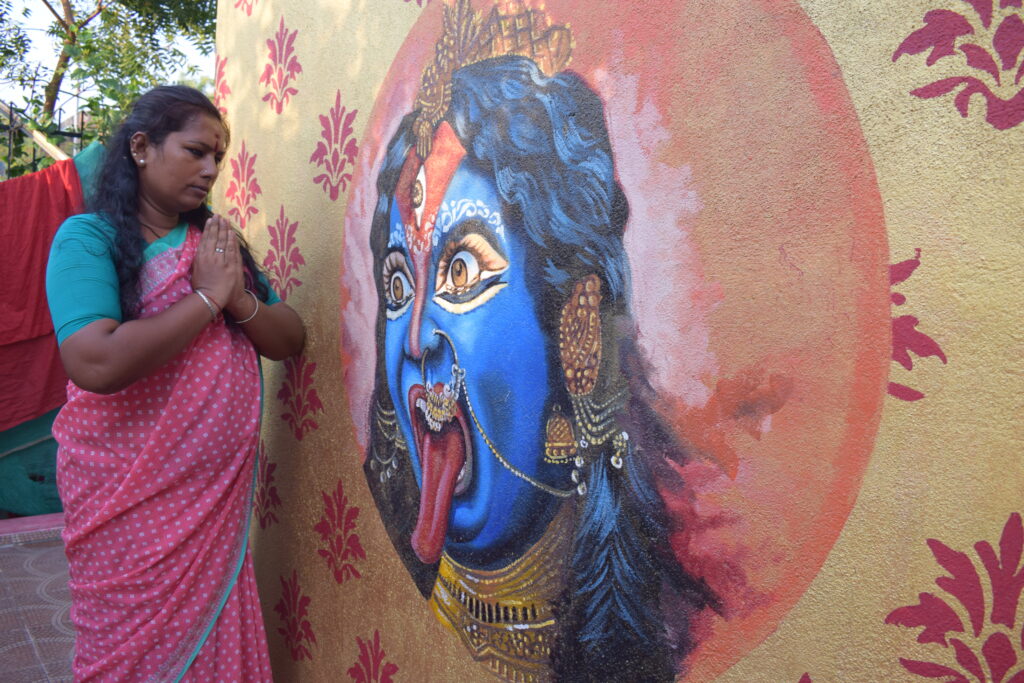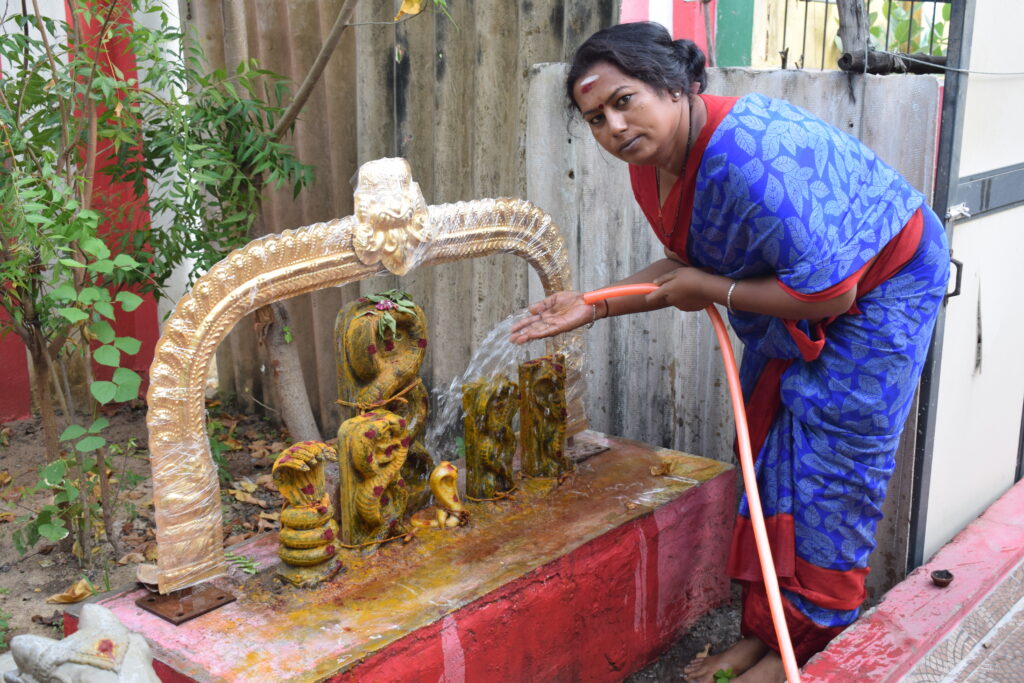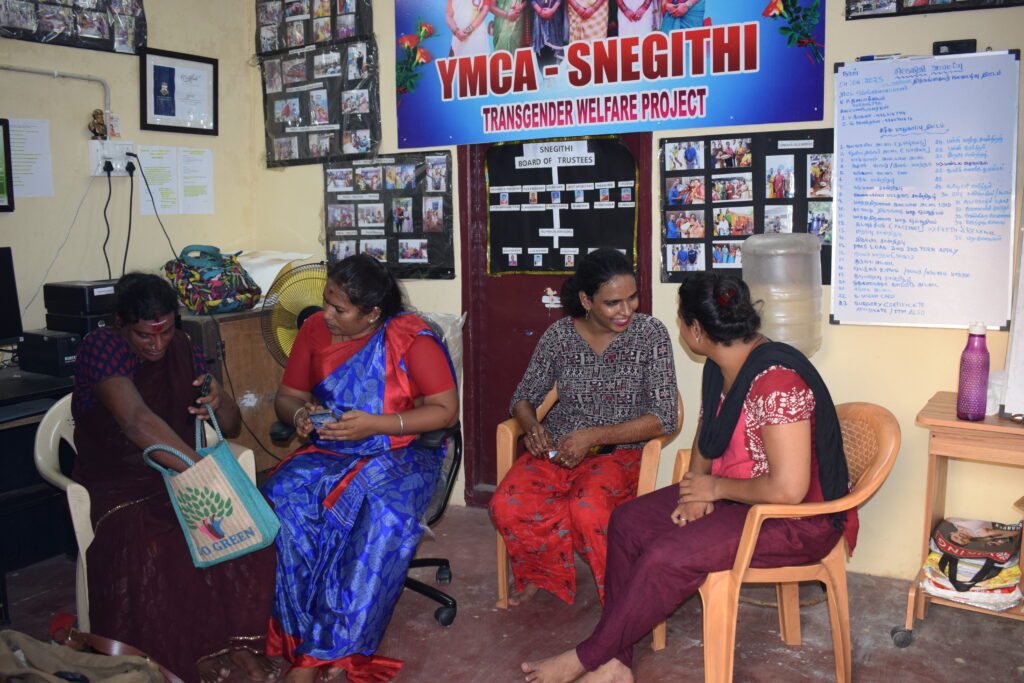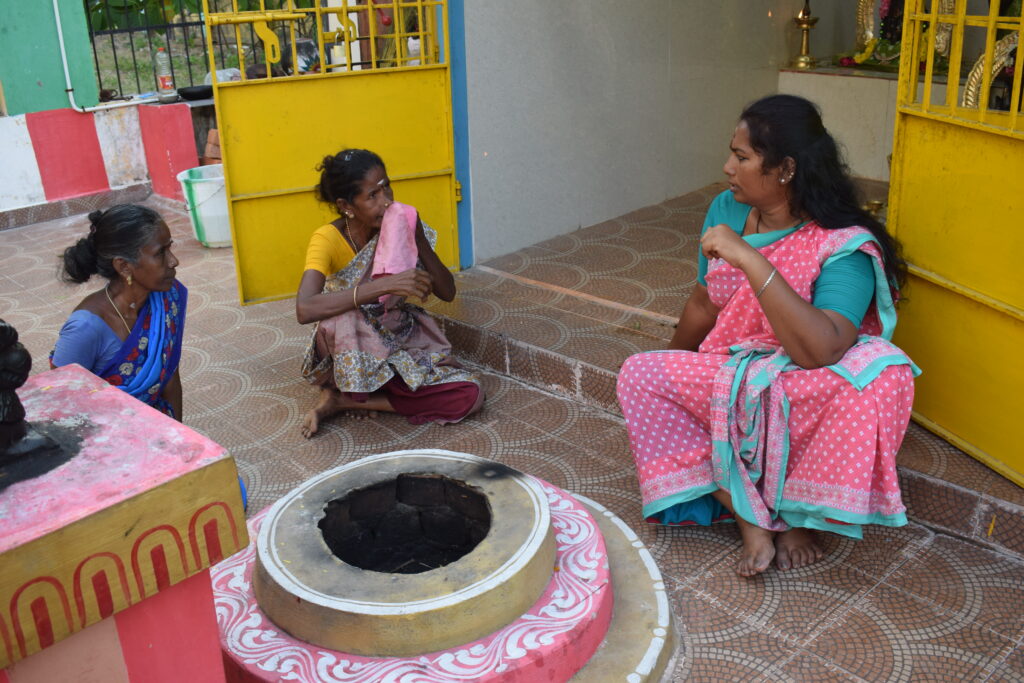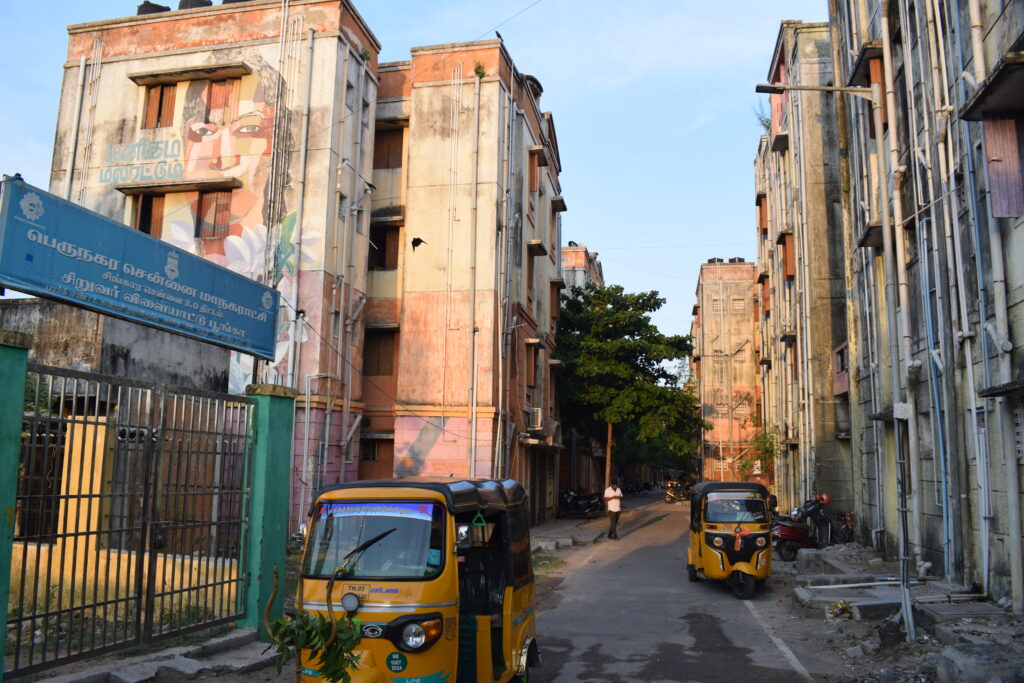The Sacred on the Fringes of Society: A Transgender Woman's Spiritual Reclamation
Content Warning: This article contains content that some readers may find distressing, including references to violence, trauma, and other sensitive subject matter. Please take care while reading.
When the fisherwomen in their bright cotton saris make their way to the Kasimedu harbor to haul up creels of fresh fish from the sandy shores every morning, Sowndharya Gopi offers an urn of water to the Hindu goddess Kali. Kali, the divine feminine who watches over Gopi’s transgender community on the fringes of the South Indian city of Chennai.
“Kali is more than a goddess for us,” says Gopi, a 40-year-old transgender activist who helped build a Kali temple in this suburb of Chennai a year and a half ago. “Her divine shakti will give my people a chance to develop their own voice.”
The Kali temple, with its vivid wall sketches of the goddess in her angry and animated avatars, — and sculpted idols of Hindu gods Ganesh, Vishnu and serpent-god Naga — draws thousands of devotees during fairs and festivals.
Its tidy precincts in a dense slum near an ecologically degraded coastline is visited by nearly a hundred devotees daily. The slum itself is a stark reminder of how people living in poverty have it especially worse after surviving the 2004 disaster, where their neighborhoods are the last to experience disaster recovery or relief.
In India, where transgender people are often denied entry into places of worship with the police citing security concerns and religious leaders invoking traditional scriptural interpretations, Gopi has stood up against many challenges.
Since the temple’s stone-laying ceremony five years ago, the activist has mobilized her community to reclaim their rights in a district where big thermal power stations, coal yards and fertilizer factories mask the lives of those living in poverty. While power plants serve the more affluent areas of Chennai, the people living around these tools of industrialization have suffered heavy pollution, contaminated water, no waste management, and a community still living in abject poverty.
“We fought hard to get housing for 236 trans people here,” says Gopi, her eyes kohl-lined and her left cheek bearing a scar from a trident-piercing religious ceremony. “But we had to fight even harder for our temple for low caste people like us.” Others questioned why transgender people deserved to have a faith center of their own.
This tumbledown fishing district was built for the survivors of the 2004 tsunami that devastated communities along the coast of the Indian Ocean and rendered thousands homeless. Gopi knew her decade-long campaigns to secure free housing for transgender people here would only be the tip of the iceberg.
The tsunami did little to check the unplanned industrial development, but fishing communities lost their livelihoods and wetlands while those living in poverty were crammed into one-room tenements on streets piled high with garbage and sewage water. “Our community was left out,” says Abhinaya Ramdas, a trans Dalit woman who calls Gopi her “mother.” “We aren’t welcome at most sacred spaces, but our temple is an inclusive space where Ma pulls all marginalized people together.”
Every morning, in her crisp sari and gold bangles, Gopi wakes the goddess from her sleep, bathes her, and lights an oil lamp as a symbol of her divine presence. On Sundays, she sweeps the surroundings clean and waters the plants around it.
During Hindu festivals like Amavasya Kali Puja and Maha Shivratri, the temple’s neighborhood becomes a fairground with thousands of worshippers turning up to witness the songs and dances of transgender people dressed as demigods.
In ancient Hindu texts, trans people were revered as demigods possessing divine status and were integrated into social life and religious rituals. Their presence was considered auspicious. But during the colonial period in India, they were criminalized and subjected to anti-trans campaigns aimed at erasing their presence from public life — they were seen as a threat to Victorian “morality.”
The lasting impact of the colonial period increased discrimination against this community over the centuries, including ostracization by families and societies, negative stereotyping, and difficulties in accessing education, jobs and health benefits.
In 2014, India’s Supreme Court recognized transgender people as a third gender. But even so, the injustices have continued. “Most of us are forced to turn to begging, sex work and blessing ceremonies to stay afloat,” says Yashika, a Muslim transgender woman who works closely with Gopi to fight discrimination faced by her community in North Chennai.
Even though Yashika grew up in a traditional Muslim family and follows Islamic practices, she says Gopi’s temple is a free space where everyone is welcome irrespective of their religion, caste, gender or community markers of identity.
While Hindu rituals are performed daily at the temple, they also host festivals to distribute consecrated food, water and clothing, as well as textbooks to children, and offerings to stray animals. Muslims perform namaaz near the temple while Christmas brings the whole community together.
When the municipal councillor resisted Gopi’s temple-building plans and bulldozers arrived to turn its foundation to rubble four years ago, the activist didn’t flinch. She rallied her community against the slum board officer who alleged they were “racketeering” and corrupting the “neighborhood.”
Against these pressures and slanders by transphobic people, the shrine to Kali emerged not only as a place of worship, but also as a safe space for transgender community meetings, crisis intervention and vocational training. They were creating sacred community, not only built on the acceptance of the divine within each other but also a spiritual remembrance and reclamation to a time when third genders were more integrated, respected and venerated.
The community held firm to the belief that Kali — the embodiment of divine feminine and primal energy — would help them carve out a distinctive identity.
“We want our children to be educated so we teach them English and Tamil at the temple,” said V. Rupakala, Gopi’s mother who adopted her when she turned 18. “We also want trans women to expand their skills, so we teach them how to string garlands, and make house mats, bags, baskets and candles.”
Gopi owes a lot to her mother for what she calls her “fierce will to survive.”
At eight years old, Gopi — then known as Chinna — knew she was different from boys in her family and those in Chennai’s urban slum where she grew up. Her father abused and shamed her daily for her “feminine ways.”
At school, children and teachers tormented Gopi with scribbled taunts against her on bathroom walls and sexual harassment. The isolation and distress only deepened when she ran away from home at the age of 16 to join a group of transgender women in the slums of Mumbai.
“I had no idea what to do, so I ran away,” Gopi recalled, her voice laced with emotion. “But the trans people in Mumbai made me beg on the streets for them.”
Gender dysphoria — the psychological anguish people feel when their gender identity is at odds with the sex they’re assigned at birth — was only getting worse with the lack of community support in Mumbai and family care at home.
“I knew I had to go through a gender reassignment surgery to fight abuse and become a more embodied person both emotionally and physically,” Gopi said. She ran back to Chennai changing trains and buses and using her most powerful tool — ‘taali,’ the act of clapping to fight off harassment.
In Chennai, Rupakala adopted Gopi as her daughter in a slum where she taught her dance and body expressionism to assert her identity. She told her daughter that “Her past should not hold her back from working for the community.” That we are divinely relational beings, and there is power in existing in and caring for community.
Under her mother’s gentle care, Gopi learnt tribal, folk and classical dances to mark her presence at social and political functions, and even signed up for a computer course to learn how to apply for government documents online.
“That was my first brush with the social sector,” says Gopi. “Then I started attending public events at hotels, clubs, associations and press meets.”
Gopi’s friend and mentor Kalki Subramaniam, one of India’s leading transgender activists and social workers, trained her in activism, community journalism, social skill-training, and much more. What followed was Gopi’s several campaigns spanning two decades to uplift her community’s most marginalized, low-caste people living on the fringes of society and in the dark underbellies of slums where she had spent much of her childhood. She helped trans people apply for government documents online, and started fronting protest marches to assert their right to livelihood and health benefits.
“Sowndharya is one of the most powerful voices in our community,” said Tanuja K, a transgender woman at Sahodaran Foundation in Chennai where Gopi offers psycho-social support and advocates for trans people’s social entitlements.
On most days, in her thin tin shed office in a bustling neighborhood of Chennai, Gopi aids HIV-affected children of trans people and disabled people from her community. She counsels them on how to seek educational support, manage crises, and find refuge in the two shelter homes in the city.
“My work is risk management round-the-clock and that’s why I need spiritual nourishment to keep going,” Gopi said, referring to how goddess Kali has helped her tap into her inner strength and courage.
The activist’s belief in Kali’s divine power even inspired her to petition the state’s then chief minister, J Jayalalitha, to grant free housing to trans people in the tsunami quarters where fisherfolk, refugees and people with disabilities had been given shelter following the devastating event.
“Some people hate her courage,” said Saira Banu, a trans woman who currently lives in the tsunami quarters. “But it’s Sowndharya’s strength that has helped us overcome catastrophes like the Vardah Cyclone and Covid.”
During the pandemic, the activists led by Gopi distributed food and relief materials among truck and ambulance drivers, beggars, traffic policemen and burial ground workers, reaching the farthest ends of the city to help those with the most limited economic means.
Yet throughout the pandemic, and even after she was awarded for her months-long relief work in 2021, the temple remained at the top of Gopi’s mind. From her childhood, she had nurtured the dream to build a temple of her own where she could pray freely and perform wedding ceremonies for couples living in poverty.
“Since its inauguration, Ma has solemnized the weddings of four low caste couples,” says Balaji, an autorickshaw driver who’s known Gopi for nearly 15 years. “It’s a big thing in a country where trans priestesses are unheard of.”
What might happen if the sacred within each other is seen so clearly and profoundly, that collective acceptance becomes reality?
When the gates to the temple were opened a couple of summers ago, the protests had died down. Political and religious leaders, railway officers and government officials graced the shrine’s flower-decked courtyard.
Gopi’s resilience not only fortified her community, but inspired another group of transgender women to build a temple close to their neighborhood soon after.
“This is called the ripple effect,” Gopi says. “When you challenge authority through love and persistence, it leads to many positive transformations.”
By Priyadarshini Sen
